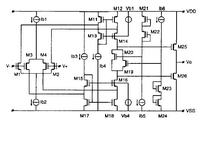stephenho
Newbie level 4

Could you please tell my how to set DC voltage level of drain of M16 and M14?
This is a rail to rail input and output amplifier and its constant-gm control circuit is omitted.
M25 and M26 are class-AB output transistors.Threshold voltage are -0.65V and 0.73V, respectively.And VDD is 3V.
So,my question are:
(1) what is exact DC voltage for the drain of M16 and M14?
(2)if DC voltage of the drain of M16 and M14 are already made certain,how to set DC voltage level of drain of M16 and M14?
Thank you all, wish you good luck.This is the first quesiton of mine.

This is a rail to rail input and output amplifier and its constant-gm control circuit is omitted.
M25 and M26 are class-AB output transistors.Threshold voltage are -0.65V and 0.73V, respectively.And VDD is 3V.
So,my question are:
(1) what is exact DC voltage for the drain of M16 and M14?
(2)if DC voltage of the drain of M16 and M14 are already made certain,how to set DC voltage level of drain of M16 and M14?
Thank you all, wish you good luck.This is the first quesiton of mine.



